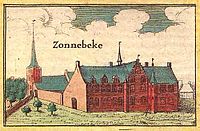Zonnebeke
| Zonnebeke | ||
|---|---|---|

|

|
|
|
|
||
| State : |
|
|
| Region : | Flanders | |
| Province : | West Flanders | |
| District : | Ypres | |
| Coordinates : | 50 ° 52 ′ N , 2 ° 59 ′ E | |
| Area : | 67.57 km² | |
| Residents: | 12,481 (Jan 1, 2019) | |
| Population density: | 185 inhabitants per km² | |
| Post Code: | 8980 | |
| Prefix: | 051 & 057 | |
| Mayor: | Dirk Sioen | |
Local government address : |
Langemarkstraat 8 8980 Zonnebeke |
|
| Website: | www.zonnebeke.be | |
Zonnebeke is a Belgian municipality in the arrondissement of Ypres in the province of West Flanders . The municipality belongs to the Flanders Region and the Flemish Community . Zonnebeke is located about 8 km east of Ypres , 15 km north of the French border and 20 km north of Lille on the Midden – West – Vlaamse – Heuvelrug (dt. Hill ridge). The municipality consists of the main town Zonnebeke and the districts Beselare , Geluveld , Passendale and Zandvoorde . The highest point is the Zandberg (64 m) in Geluveld. With an area of 67.57 km², Zonnebeke has 12,481 inhabitants (as of January 1, 2019).
Community structure
| # | Surname | Area (ha) | Population (2014) |
|---|---|---|---|
| I. | Zonnebeke | 16.55 | 4,472 |
| II | Beselare | 14.33 | 2,684 |
| III | Geluveld | 7.79 | 1,553 |
| IV | Passendale | 22.22 | 3.152 |
| V | Zandvoorde | 6.68 | 521 |
| # | Place name | local community |
|---|---|---|
| a | Moorslede | Moorslede |
| b | Dadizele | |
| c | Geluwe | Wervik |
| d | Wervik | |
| e | Comines | Comines warning tone |
| f | Houthem | |
| G | Hollebeke | Ypres |
| H | Zillebeke | |
| i | Ypres | |
| j | Langemark | Langemark-Poel Chapel |
| H | Poel Chapel | |
| l | West Rozebeke | Staden |
| m | Oostnieuwkerke | |
| n | Roeselare | Roeselare |
history

In pre-Christian times, the ridge in Zonnebeke formed the border between the tribal areas of the Morinians and the Menapians . Traces of the Roman occupation have also been found in various places. After Christianization, this geographical feature functioned as a dividing line between the dioceses of Doornik and Terwaan in the region . In the Middle Ages, Zonnebeke was repeatedly the scene of bloody battles, for example in 1382 between the army of the French king and the gentry under the leadership of Filips van Artevelde.
Zonnebeke was first mentioned in a document when a chapter was founded here by Bishop Drogo van Terwaan in 1072 . Initially equipped with three canons, in 1110 there were already seven who maintained and developed the monastery . In 1142 it became an abbey that committed itself to the rule of Augustine , as already exemplified by the Order of Arrouaise . The monastery church stood on the place where the Onze-Lieve-Vrouwekerk is located today. In 1101 a Benedictine monastery , the so-called Nonnenbosabbey, was founded in a forest area nearby .
During the iconoclasm of the Reformation in 1566, both abbeys were devastated. Another raid in 1579 led the monastery residents to seek refuge in Ieper . As a result of looting by mercenaries and epidemics, the region became increasingly depopulated, until in 1608 Carolus de Boisot took over the management of the monastery as the new abbot: the monks who had fled returned in 1609 and brought the abbey to a new prosperity, including through reconstruction the church and the establishment of a school. The abbey remained the cultural and economic center of the village until the French occupied the country. When they confiscated the abbey in 1796, the monks were evicted and the monastery buildings and goods and the land on them were sold.
Except for the church, the abbot's apartment and the abbey courtyard, all buildings were demolished in the first quarter of the 19th century. The remaining structures were destroyed in World War I when the area was fiercely contested. Zonnebeke was under German control after the 1st Ypres Battle (see also Kampf um Höhe 60 ), but was defeated by the British Army (in which associations from the United Kingdom , Canada and the ANZAC Corps were involved) in the 3rd Ypres Battle in 1917 conquered heavy losses. Since the battle ended with the conquest of the village and today's part of Zonnebeke Passendale or Passchendaele, the entire battle is partly referred to with the synonym Passchendaele . The fighting left a desert landscape.
At Zonnebeke there are numerous memorials and war cemeteries for the fallen of World War I, including the Tyne Cot Commonwealth War Graves Cemetery and Memorial to the Missing , where at least 11,900 soldiers are buried.
Personalities
- Jules Destrooper (1856–1934), baker and founder of the Biscuiterie Jules Destrooper , was born in the village of Beselare.
Web links
- Homepage of Zonnebeke ( Dutch , brief information in German , English , French )
- First World War in Zonnebeke (history of the military cemeteries from the First World War around Zonnebeke)
- Knopte historiek van de Augustijnenabdij te Zonnebeke. (History of the Augustinian Abbey of Zonnebeke; Dutch)
swell
- ↑ a b About Zonnebeke. Divorce.
- ↑ Léopold van Hollebeke: L'abbaye de Nonnenbossche de l'ordre de Saint Benoit, près d'Ypres, 1101-1796, suivi du Cartulaire de cette Maison. Brugge, 1865

